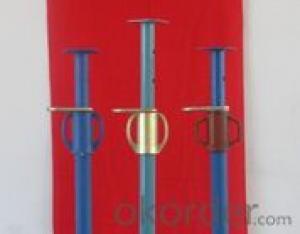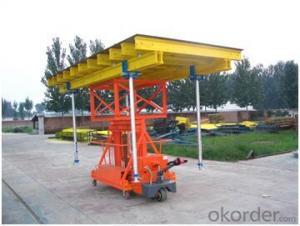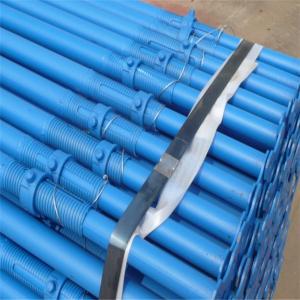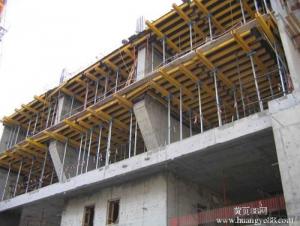Construction formwork support Steel Prop
- Loading Port:
- Tianjin
- Payment Terms:
- TT OR LC
- Min Order Qty:
- 10000 PCS
- Supply Capability:
- 10000 PCS/month
OKorder Service Pledge
OKorder Financial Service
You Might Also Like
Quick Details
| Model Number: | QSFW3040-3057 | ||
| Type: | Formwork | Surface finish: | painted, galvanized, hot dipped galvanized |
Packaging & Delivery
| Packaging Detail: | Bundle or according to your requirement |
| Delivery Detail: | 20-40 days |
Specifications
1) Surface finish: painted, galvanized, hot dipped galvanized
2) Steel grade Q235,following UNI EN 10219-1/2;
1) Colour: red color painted,orange or other color( upon your request )
2) Hot dipped galvanized:thickness guaranteed Min.50µm following UNI EN 40.
3) Type: Acrow Prop ; Portuguese type prop ; U-head prop ; Italian type prop (popular) ; Prop with casting sleeve ; Prop all galv. ; Prop with casting sleeve ; Spanish type prop ; Prop with reinforced base ; Heavy duty prop ; French type prop
4) We have been supplying to the following countries with props:
ITALY,SPAIN,FRANCE,GERMANY,PORTUGAL,BELGIUM,HOLLAND,U.K. IRELAND,DENMARK,AUSTRALIA,NEW ZEALAND,U.S.A. BRAZIL,ARGENTINA,ect.
5) All our props are made as per Euorpean standard and Australian standard and American standard.All our customers are very happy with our quality of props.
| Popular Prop | Spec. | Weight |
Italian Type Props Steel prop External Diameter :Φ56x1.6mm, Internal Diameter:Φ48x1.8mm | 220/400CM | 11.20kgs |
| 200/360CM | 10.00kgs | |
| 160/290CM | 8.50kgs |
- Q: Can steel props be used for temporary support in oil storage tank construction?
- Yes, steel props can be used for temporary support in oil storage tank construction. Steel props are commonly used in construction projects to provide temporary support and stability to structures during the construction process. They are designed to withstand heavy loads and provide a secure and reliable support system. In the case of oil storage tank construction, steel props can be used to support the tank during the initial stages of construction, ensuring that it remains stable and balanced until it is fully completed and can support its own weight. Steel props can be easily adjusted and repositioned, making them a versatile and practical choice for temporary support in various construction projects, including oil storage tank construction.
- Q: How do you protect steel props from environmental damage?
- To protect steel props from environmental damage, it is important to implement proper preventive measures. This can include applying protective coatings such as paint, varnish, or rust-resistant coatings to the steel props. Regular inspections should also be conducted to identify any signs of corrosion or damage, and prompt repairs or replacements should be carried out. Additionally, storing the steel props in a dry and well-ventilated area when not in use can help prevent exposure to moisture and other environmental elements that may cause damage.
- Q: What are the standard sizes of steel props?
- The standard sizes of steel props vary depending on the specific requirements of construction projects. However, there are common sizes that are widely used in the industry. These sizes typically range from 0.5 meters to 5 meters in length, with adjustable height options. The diameters of steel props can vary as well, but commonly range from 40mm to 60mm. It is important to note that the specific sizes of steel props may differ based on the load-bearing capacity needed for each project. Therefore, it is crucial to consult engineering and construction standards to determine the appropriate size of steel props for a given application.
- Q: What are the common sizes available for steel props?
- The common sizes available for steel props vary, but typically range from 1.8 meters to 5 meters in length.
- Q: How do you secure a steel prop in place?
- To ensure a steel prop is securely in place, there are several steps that can be followed: 1. Select the appropriate size and type of steel prop: It is important to choose a prop that can adequately support the weight and load it will bear. 2. Position the prop correctly: Place the steel prop in the desired location, ensuring it is properly aligned and positioned on a stable and level surface. 3. Adjust the height as needed: Extend or retract the prop to the desired height using the adjustable screw mechanism commonly found in steel props. 4. Secure the prop: Once the prop is at the desired height, use the appropriate locking mechanism (such as turning a handle, tightening a nut, or using a locking pin) to secure it in place. 5. Check for stability: After securing the prop, test its stability by giving it a gentle shake or push. If it remains steady, it is secure. If it wavers or seems unstable, reposition or adjust it until it is stable. 6. Test the load-bearing capacity: If the task involves placing a load on the prop, gradually add the load while monitoring its stability. It is important not to exceed the recommended maximum load capacity to avoid accidents. 7. Regularly inspect the prop: Periodically inspect the prop to ensure it remains secure and in good condition. Look for any signs of wear, damage, or loosening of the locking mechanism. Promptly address any issues to maintain stability and safety. By following these steps, you can effectively secure a steel prop in place, ensuring stability and safety for your construction or support needs.
- Q: What are the common accessories used for securing steel props to existing structures?
- There are several accessories commonly used to secure steel props to existing structures: 1. The first accessory is prop heads, which are metal plates or brackets that fix the top end of the steel props to the structure. They create a stable and secure connection point. 2. Another accessory is prop base plates, which are flat metal plates placed at the bottom end of the steel props. These plates distribute the load evenly and prevent the props from sinking into the ground. Base plates also provide stability and prevent tipping. 3. Prop pins are metal pins or bolts used to secure the prop heads and base plates to the existing structure. These pins ensure a strong and reliable connection between the props and the structure. 4. Prop connectors are metal connectors or couplers used to join multiple steel props together, creating longer support systems. They allow for adjustable height and provide additional stability when props are used in a row. 5. Prop wedges are small metal wedges inserted between the prop heads and the structure. They provide a tight fit, preventing any movement or slippage. These wedges help secure the props in place and ensure stability during use. 6. Prop braces are additional support beams or struts used to reinforce the steel props, increasing their load-bearing capacity. These braces are particularly useful for heavy loads or spanning long distances. In conclusion, these accessories are essential for securing steel props to existing structures, ensuring safety, stability, and effective load distribution. They are designed to withstand various forces and conditions, providing a reliable solution for temporary or permanent support systems.
- Q: Can steel props be used in different weather conditions?
- Yes, steel props can be used in different weather conditions. Steel is a strong and durable material that can withstand various weather conditions such as rain, wind, and extreme temperatures. However, it is important to ensure proper maintenance and protection to prevent rust and corrosion that can be caused by prolonged exposure to harsh weather elements.
- Q: Are steel props suitable for use in underground utility tunnel construction?
- Yes, steel props are suitable for use in underground utility tunnel construction. Steel props, also known as steel shoring or steel supports, are commonly used in construction projects to provide temporary support to structures or excavations. They are designed to withstand heavy loads and provide stability in various applications, including underground tunnels. Steel props offer several advantages for use in underground utility tunnel construction. Firstly, they are strong and durable, capable of supporting the weight of the tunnel and any additional loads such as utilities or equipment. They can be adjusted to different heights and lengths, allowing for flexibility in the construction process. Additionally, steel props are easy to install and remove, making them ideal for temporary applications. They can be quickly assembled and disassembled, which helps to reduce construction time and costs. Moreover, steel props can be reused in other projects, making them a cost-effective solution in the long run. In terms of safety, steel props provide a stable and secure support system for workers and equipment during tunnel construction. They are designed to withstand lateral forces and minimize the risk of collapse or accidents. This ensures the safety of workers and helps to prevent potential damage to the tunnel or utilities. Overall, steel props are a suitable choice for use in underground utility tunnel construction. They offer strength, durability, flexibility, and safety, making them an effective solution for supporting the excavation and construction of tunnels.
- Q: How do you prevent steel props from sliding on icy surfaces?
- In order to prevent steel props from sliding on icy surfaces, there are several actions that can be taken: 1. Incorporate anti-slip mats or grips: Position rubber or anti-slip mats beneath the steel props to establish traction and prevent sliding. These mats are specifically designed to grasp onto the icy surface, generating friction and ensuring stability. 2. Fasten props with straps or clamps: Utilize straps or clamps to secure the steel props to nearby structures, such as walls or poles. This will assist in stabilizing the props and preventing sliding on the icy surface. 3. Increase weight or ballast: Enhancing the weight on the steel props can enhance stability and decrease the likelihood of sliding. Additional weights can be attached to the props, or sandbags can be used as ballast to anchor them down. 4. Establish a stable base: Remove any snow or ice from the ground where the steel props will be placed. Level the surface and ensure it is free from any debris that could affect stability. If feasible, create a solid foundation for the props by using plywood or other flat materials. 5. Implement ice melt or traction aids: Apply ice melt or other traction aids to the surface surrounding and underneath the steel props. These substances can assist in melting the ice and improving grip, thereby reducing the risk of sliding. 6. Monitor and maintain: Regularly inspect the props and the surrounding area for any indications of movement or instability. If necessary, readjust the props, add more traction aids, or reinforce the stability measures to maintain a secure setup. Ensuring safety and taking necessary precautions when working with steel props on icy surfaces is of utmost importance. By implementing these preventive measures, you can minimize the risk of sliding and ensure a stable and secure setup.
- Q: How do steel props contribute to the prevention of structural settlement?
- Steel props contribute to the prevention of structural settlement by providing temporary support to load-bearing elements of a structure during construction or renovation. These props help distribute the weight of the structure and limit any potential movement or settlement, ensuring the stability and integrity of the building.
Send your message to us
Construction formwork support Steel Prop
- Loading Port:
- Tianjin
- Payment Terms:
- TT OR LC
- Min Order Qty:
- 10000 PCS
- Supply Capability:
- 10000 PCS/month
OKorder Service Pledge
OKorder Financial Service
Similar products
Hot products
Hot Searches
Related keywords
























